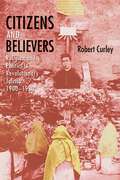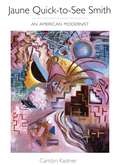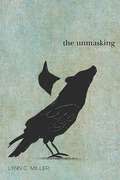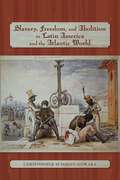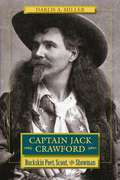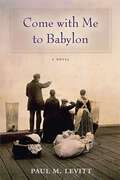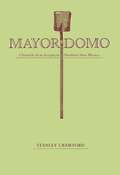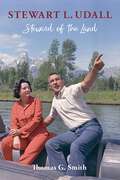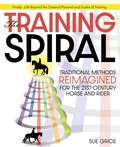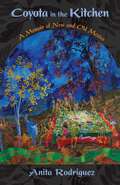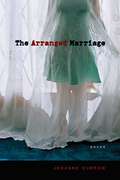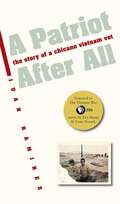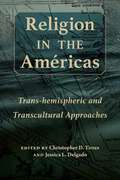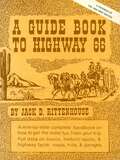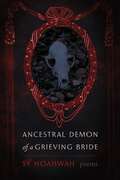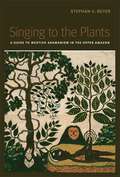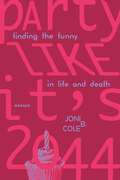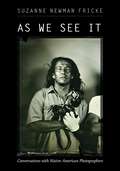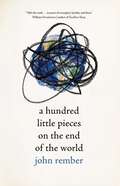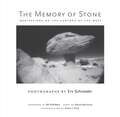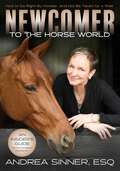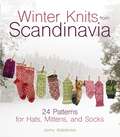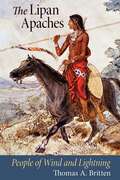- Table View
- List View
Citizens and Believers: Religion and Politics in Revolutionary Jalisco, 1900–1930
by Robert CurleyThis book shows the centrality of religion to the making of the 1910 Mexican revolution. It goes beyond conventional studies of church-state conflict to focus on Catholics as political subjects whose religious identity became a fundamental aspect of citizenship during the first three decades of the twentieth century.
Jaune Quick-to-See Smith: An American Modernist
by Carolyn KastnerThe first full-length critical analysis of the paintings of Jaune Quick-to-See Smith, this book focuses on Smith&’s role as a modernist in addition to her status as a wellknown Native American artist. With close readings of Smith&’s work, Carolyn Kastner shows how Smith simultaneously contributes to and critiques American art and its history.Smith has distinguished herself as a modernist both in her pursuit of abstraction and her expressive technique, but too often her identity as a Native American artist has overshadowed these aspects of her work. Addressing specific themes in Smith&’s career, Kastner situates Smith within specific historical and cultural moments of American art, comparing her work to the abstractions of Kandinsky and Miró, as well as to the pop art of Rauschenberg and Johns. She discusses Smith&’s appropriation of pop culture icons like the Barbie doll, reimagined by the artist as Barbie Plenty Horses. As Kastner considers how Smith constructs each new series of artworks within the artistic, social, and political discourse of its time, she defines her contribution to American modernism and its history. Discussing the ways in which Smith draws upon her cultural heritage—both Native and non-Native—Kastner demonstrates how Smith has expanded the definitions of &“American&” and &“modernist&” art.
The Unmasking: A Novel
by Lynn C. MillerBest friends Bettina, Miriam, and Fiona are shocked when their dean of liberal studies dies in a single-car accident amid accusations of mishandling university funds. They suspect murder, especially after learning that the dean&’s estranged wife will inherit three million dollars. Events take a surprising turn when they travel from Austin, Texas, to a Chautauqua performance in Silver City, New Mexico, where they join several others, some with questionable motives, including the dean&’s wife and her lover. In the close confines of the lodge, the group brings to life remarkable women from history—including Victoria Woodhull, Gertrude Stein, Edith Wharton, Mabel Dodge Luhan, and Virginia Woolf. But when one woman is kidnapped and another disappears, the friends&’ lives are forever changed as they realize that the masks we wear often hide chilling truths.
Slavery, Freedom, and Abolition in Latin America and the Atlantic World (Diálogos Series)
by Christopher Schmidt-NowaraThe last New World countries to abolish slavery were Cuba and Brazil, more than twenty years after slave emancipation in the United States. Why slavery was so resilient and how people in Latin America fought against it are the subjects of this compelling study. Beginning with the roots of African slavery in the fifteenth- and sixteenth-century Iberian empires, this work explores central issues, including the transatlantic slave trade, labor, Afro-Latin American cultures, racial identities in colonial slave societies, and the spread of antislavery ideas and social movements. A study of Latin America, this work, with its Atlantic-world framework, will also appeal to students of slavery and abolition in other Atlantic empires and nation-states in the early modern and modern eras.
Captain Jack Crawford: Buckskin Poet, Scout, and Showman
by Darlis A. MillerJack Crawford (1847–1917) entertained a generation of Americans and introduced them to their frontier heritage. A master storyteller who presented the West as he experienced it, he was one of America&’s most popular performers in the late nineteenth century.Dressed in buckskin with a wide-brimmed sombrero covering his flowing locks, Crawford delivered a &“frontier monologue and medley&” that, as one New York City journalist reported, &“held his audience spell-bound for two hours by a simple narration of his life.&”In this biography, Darlis Miller re-creates his experiences as a scout, rancher, miner, reformer, husband and father, and poet and entertainer to reinterpret the American Dream and the lure of getting rich pursued by many during the Gilded Age.
Come with Me to Babylon
by Paul M. LevittIn 1910 the Cohen family, in search of the Golden Medina, undertakes a dangerous journey from Russia to the United States, where the new world exposes family secrets, cultural conflicts, the corruption of the American Dream, and love's divides. Traveling in steerage to Ellis Island, the family endures the poverty and dirt of New York City and retreats to a farm in southern New Jersey--to find not the agricultural Eden they were promised, but Babylon. Told in several voices, this tale bears witness to a new generation learning to find hope in a land that often sacrifices human decency for profit and greed.
Mayordomo: Chronicle of an Acequia in Northern New Mexico
by Stanley CrawfordIrrigation ditches are the lifelines of agriculture and daily life in rural New Mexico. This award-winning account of the author's experience as a mayordomo, or ditch boss, is the first record of the life of an acequia by a community participant.
Stewart L. Udall: Steward of the Land
by Thomas G. SmithAs a three-term member of Congress and as the secretary of the interior in the Kennedy and Johnson cabinets (1961–1969), Stewart L. Udall (1920–2010) was a distinguished public servant and one of the great environmental leaders in US history. This book, the first biography of Udall, introduces his work to a new generation of Americans concerned with the environment. The author traces the influences on Udall&’s career, the evolution of his views on conservation, and his setbacks as well as his triumphs.In addition to his efforts to preserve wilderness areas and protect the planet, Udall advocated reforming the seniority system in Congress, limiting the production and testing of nuclear weapons, promoting coexistence with the Soviet Union, and helping oppressed peoples in emerging nations. A visionary leader, Udall was inspired by his pioneering Mormon forebears who helped settle the Arizona high plateau, where he first connected with the natural world.
Sweeney
by Robert JulyanThe fictional High Plains village of Sweeney, New Mexico, population 856 and falling, is like so many small towns in rural America--once vibrant and alive but now a dry husk of obsolescence, decay, and despair. Only its few remaining citizens care that it not die like so many other towns, but when a handful of them concoct a plot to draw attention to their hometown, the result is a hilarious romp through the oddities and opportunities of small town life. Aliens, nudists, naked bull riders, Druids, phony Indians, and real Indians--all play a role in Sweeney's quixotic journey of survival and self-discovery.
Training Spiral
by Sue GriceEngaging new ways to understand and implement time-proven systems of horse training. The &“Scales of Training,&” &“Training Scale,&” and &“Training Pyramid&” are familiar terms to riders. Around the globe and across disciplines, equestrians hear reference to them or study them as a part of their equestrian education. Dressage rider and trainer Sue Grice grew up with these concepts, too, and like many, found them to be not only fairly boring, but also confusing when it came to actually implementing them as part of daily training. In the course of her work with other riders, she came to realize that although many seemed to know about the Scales of Training in theory, few actually applied them in practice. Grice determined that this was because there was really no clear framework or methodology for implementing the system in a progressive manner. So Grice conceived a new approach based on the standard but with a focus on a better rate of success. Success could be achieved when the rider was engaged with the system and understood how to continually adhere to it, even as advances (or falters) might occur. For over 30 years she has continued to develop and apply her ideas, and now she has finally brought them together to share with the world in this book. Here readers find a detailed plan for applying what Grice calls the &“Training Spiral.&” She does not try to rewrite what history has shown to work in the development of the riding horse, but instead simply provides a fresh framework that enables riders and trainers to: Apply the classical elements of the Training Scale in a more progressive and logical manner, and, Employ them systematically within daily training as well as over a longer period of time. Grice provides clear explanations of how to use each of the six elements (Rhythm, Suppleness, Contact, Impulsion, Straightness, and Collection), how the elements are to be used in order, and what can go wrong if they are applied in the wrong order. Clear examples are given at all levels of training, and detailed case studies demonstrate how the Training Spiral can succeed where traditional systems have failed. The spiral structure provides a means of applying the Scales of Training in practice that is not just logical but also extremely easy to follow. The clarity of Grice's approach also helps horses understand what is being asked of them, leading to a happier relationship between horses and riders, and training that progresses more quickly and easily overall. The Training Spiral is an invaluable and immensely practical guide for trainers and riders at all levels, from novice to advanced.
Living Well with Dr. Michelle: A Comprehensive Handbook for Optimal Health and Unlimited Energy
by Dr. Michelle C. JorgensenFar too many of us have no idea how our bodies really work. The good news? This comprehensive guide provides a regenerative, energy-boosting approach to wellness that will empower you to live the life you want.Holistic dentist and wellness provider Dr. Michelle Jorgensen has seen patient after patient come to her overwhelmed by a deluge of options, misinformation, and conflicting opinions. In today&’s sea of often confusing advice on how to make healthy choices, it can be challenging to weed out the valuable tips from all the rest. She&’s here to change that. With more than 30 recipes, from healthy smoothies to slow cooker staples, Living Well with Dr. Michelle simplifies the quest for better health based on the best practices from time-tested natural wisdom and evidence-based modern science to: Promote total body wellness starting with the tiny, living building blocks that make up your body Tap into nature&’s five elements—fire, earth, plants, water, and air—for better health in everyday life Harness the power of electrons to deliver the energy your body needs to repair and recharge Jumpstart your journey to better health by knowing what questions to ask and taking an active role in your wellness Packed with self-assessment tools and other resources to help you enact these principles in your own life, Living Well with Dr. Michelle will ensure that you can not only stay healthy, but learn to live well.
Coyota in the Kitchen: A Memoir of New and Old Mexico (Querencias Series)
by Anita RodríguezThis book of stories and recipes introduces two eccentric families that would never have eaten together, let alone exchanged recipes, but for the improbable marriage of the author&’s parents: a nuevomexicano from Taos and a painter who came from Texas to New Mexico to study art. Recalling the good and the terrible cooks in her family, Anita Rodríguez also shares the complications of navigating a safe path among contradictory cultural perspectives. She takes us from the mountain villages of New Mexico in the 1940s to sipping mint juleps on the porch of a mansion in the South, and also on a prolonged pilgrimage to Mexico and back again to New Mexico. Accompanied by Rodríguez&’s vibrant paintings—including scenes of people eating on fiesta nights and plastering an adobe church—Coyota in the Kitchen shows how food reflects the complicated family histories that shape our lives.
The Arranged Marriage: Poems (Mary Burritt Christiansen Poetry Series)
by Jehanne DubrowWith her characteristic music and precision, Dubrow&’s prose poems delve unflinchingly into a mother&’s story of trauma and captivity. The poet proves that truth telling and vision can give meaning to the gravest situations, allowing women to create a future on their own terms.
A Patriot After All: The Story of a Chicano Vietnam Vet
by Juan RamirezJuan Ramirez always believed he would die in Vietnam. As a teenager growing up in the San Francisco area in the early 1960s, Nam was there, just over the horizon, like the distant thump of artillery. His father and uncles had served in World War II, another uncle in Korea. Numerous cousins had enlisted. At nineteen, Ramirez decided to embrace the war. In 1968, the year of the Tet offensive, Ramirez joined the U.S. marines.Two bloody tours later, Ramirez survived, but at immense cost. Twice wounded, undesirably discharged, and plagued by survivor's guilt, Ramirez surveys the toll of Vietnam on flesh and spirit in this captivating memoir.Ramirez tells his story in a voice not often heard from the war, that of a Chicano soldier. By tracing his roots, and exploring the cultural pressures and social demons that weighed on his family and community, Ramirez offers an unflinching look at the fall and redemption of one Mexican American veteran.Ramirez has given us a rather unique and clear-eyed view inside the life and times and thoughts of a young Chicano who joins the marines and goes to Vietnam to find his destiny. . . . Fascinating reading.--Joseph L. Galloway, author of We Were Soldiers Once . . . And Young.
Religion in the Américas: Trans-hemispheric and Transcultural Approaches (Religions of the Americas Series)
by Christopher D. Tirres and Jessica L. DelgadoReligion in the Américas explores the fluid, dynamic, and complex nature of religion across Latin America and its diasporic communities in the United States. Utilizing a transdisciplinary and trans-hemispheric lens, this groundbreaking anthology transcends traditional scholarly boundaries—geographical, disciplinary, and temporal—as it explores ideas and cultural practices that share a common history of Iberian colonialism.This robust collection of essays forges a dialogue among scholars throughout the Americas who represent a variety of disciplinary perspectives. The book is divided into five sections: &“Fluidity in the Afro-Latine Diaspora,&” &“Aesthetics in Las Américas,&” &“Critical Feminist Epistemologies and Activism,&” &“The Limits of Institutional Religion,&” and &“Spiritual Invasions and Contagions.&” Throughout the volume, the concept of &“experience&” serves as a foundational lens, as chapters examine how individuals and communities actively interpret and negotiate their realities within diverse historical and social contexts.Focusing on religion as a culturally conditioned epistemic practice, Religion in the Américas invites readers to engage with religion in the Americas on multiple, intersecting levels of knowledge, including local insights, scholarly analyses, and the positionality and queries of readers themselves. The book&’s dialogical approach encourages not only continual reevaluation of the complexities of religious experience in the Americas but also creative innovation that will inspire new avenues of inquiry.
A Guide Book to Highway 66
by Jack D. RittenhouseThis is an exact facsimile of the first guidebook of its kind to the full length of the famous Route 66, from Chicago to Los Angeles. It was first published in 1946. Route 66 is part of American history now, and this guide is useful for those who wish to follow the old road in lieu of driving on the interstate highways that have replaced it. The book is divided into nine sections, corresponding to the journeys between stops by the average motorist. In addition, this structure makes the book useful to the traveler who wishes to follow only part of old US 66. Rittenhouse includes altitude and 1940 population figures for each town, with information on reliable garages, tourist courts (the forerunner's of today's motels), and other local attractions. This fascinating piece of Americana recalls a day before the arrival of franchised restaurants and hotels, when travel still held some surprises. Anyone driving in the West or recalling a trip in the good old days will enjoy it.
Ancestral Demon of a Grieving Bride: Poems (Mary Burritt Christiansen Poetry Series)
by Sy HoahwahFractured storytelling for a fractured world, Ancestral Demon of a Grieving Bride draws readers into a world that appears eerily familiar but unsettling as well. Fierce, visceral, sometimes funny, and wholly original, Hoahwah&’s poems will linger in a reader&’s dreams long after she&’s closed the book.
Singing to the Plants: A Guide to Mestizo Shamanism in the Upper Amazon
by Stephan V, BeyerIn the Upper Amazon, mestizos are the Spanish-speaking descendants of Hispanic colonizers and the indigenous peoples of the jungle. Some mestizos have migrated to Amazon towns and cities, such as Iquitos and Pucallpa; most remain in small villages. They have retained features of a folk Catholicism and traditional Hispanic medicine, and have incorporated much of the religious tradition of the Amazon, especially its healing, sorcery, shamanism, and the use of potent plant hallucinogens, including ayahuasca. The result is a uniquely eclectic shamanist culture that continues to fascinate outsiders with its brilliant visionary art. Ayahuasca shamanism is now part of global culture. Once the terrain of anthropologists, it is now the subject of novels and spiritual memoirs, while ayahuasca shamans perform their healing rituals in Ontario and Wisconsin.Singing to the Plants sets forth just what this shamanism is about--what happens at an ayahuasca healing ceremony, how the apprentice shaman forms a spiritual relationship with the healing plant spirits, how sorcerers inflict the harm that the shaman heals, and the ways that plants are used in healing, love magic, and sorcery.
Party Like It's 2044: Finding the Funny in Life and Death
by Joni B. ColeAuthor Joni B. Cole worries that Vlad the Impaler may be a distant cousin. She feuds with a dead medium. She thinks (or overthinks) about insulting birthday cards, power trips, and the real reason writers hate Amazon. And she wishes, really wishes, all those well-meaning people would stop talking about Guatemala. At once irreverent and thought provoking, Cole&’s collection is a joy ride through eclectic essays that arrives smack on that sweet spot between soul searching and social commentary, between humor and heft.
As We See It: Conversations with Native American Photographers
by Suzanne Newman FrickeIn As We See It, Suzanne Newman Fricke invites readers to explore the work and careers of ten contemporary Native American photographers: Jamison Banks, Anna Hoover, Tom Jones, Larry McNeil, Shelley Niro, Wendy Red Star, Beverly Singer, Matika Wilber, William Wilson, and Tiffiney Yazzie. Inspired by As We See It, an exhibition of these artists&’ work cocurated by Fricke in 2015, the book showcases the extraordinary achievements of these groundbreaking photographers. As We See It presents dialogues in which the artists share their unique perspectives about the history and current state of photography. Each chapter includes an overview of the photographer&’s career as well as examples of the artist&’s work. For added context, Fricke includes an introduction, a preface that explores the original exhibition of the same name, and an essay that challenges the ghost of Edward S. Curtis, whose work serves as a counterpoint to the photography of contemporary Native Americans. The text is designed to be read as a whole or in sections for anyone teaching Native American photography. As We See It is an invaluable addition to the library of anyone interested in Native American photography and will be the key source for teachers, researchers, and lovers of photography for years to come.
A Hundred Little Pieces on the End of the World
by John RemberWritten with clarity, tenacity, humor, and warmth, A Hundred Little Pieces on the End of the World attempts to find tolerable ethical positions in the face of barely tolerable events—and the real possibility of an intolerable future. It is a compelling, surprising, disturbing, and highly literate work of reportage and contemplation. It is both a collection of gentle-spirited wisdom and a rumination on ruin, as if distilled in equal measure from the spirits of Norman Maclean&’s A River Runs Through It and Cormac McCarthy&’s The Road.Through these ten essays, each further broken into ten smaller pieces, Rember examines the practical and ethical dilemmas of climate change, population, resource depletion, and mass extinction. At the same time, he never forgets those improbable connections between human beings that lead to moments of joy, empathy, and grace.
The Memory of Stone: Meditations on the Canyons of the West
by Erv SchroederThis intimate portrait of the Colorado Plateau celebrates the landscape in photographs and writing. Erv Schroeder&’s photographs bear witness to the primordial forces of the earth—the raw power that moved and shifted huge hunks of rock to form natural stone sculptures. Schroeder&’s prints engage the viewer on an intimate level, acting as portals to contemplative worlds, inviting the viewer on an inner journey. As further guides to the landscape and its significance, he has invited indigenous writers—Natanya Ann Pulley, Rainy Dawn, Esther G. Belin, Orlando White, and Tacey M. Atsitty—to contribute poems that speak about these places. Celebrated Acoma storyteller Simon J. Ortiz introduces the photography and poetry with his musings on stone. In addition, an essay by geologist Marcia Bjornerud explores the geology of the region.
Newcomer to the Horse World
by Andrea SinnerAndrea Sinner embarked on her equestrian journey at age 30 while navigating an all-consuming global consulting career. A neophyte with little to guide her but passion, she found the horse world's customs and complexities challenging. After 25 years of hard-earned lessons and continuous growth, Sinner now shares the wisdom she fought to gain along the way, with a book for adults who are newcomers to the equestrian lifestyle as she once was. Whether riders themselves or the parents of horse-crazy children, the equestrian realm can be daunting and often perplexing to those beginning their journey with horses. Luckily, Sinner&’s book serves as a comprehensive insider's guide, offering a sensible pathway to enjoying the company of horses while always advocating for their welfare. Sinner&’s advice is clear and on point, helping readers confidently find their place among both the professionals and the lifelong enthusiasts in this unique world. Rather than focusing on horse care or riding—topics she acknowledges are well covered in existing published works—Sinner aims to help readers integrate smoothly into the equestrian community on their own terms. She deftly demystifies the often bewildering culture, traditions, conventions, and unwritten rules, and offers &“watch-outs&” to help shield the novice from the less savory characters and practices that unfortunately can be encountered in the industry. You&’ll find advice on: Appreciating the unique language, relationships, and responsibilities Defining your values, boundaries, and objectives Understanding the financial costs, including (most importantly) exceptional horse care Finding the right barn, trainer, and horse Building a quality horse care team Being a good client and member of the barn Preparing for the psychological elements of the sport And much more Throughout, Sinner delves into what it means to intend to &“do right&” by horses and guides readers on extending their involvement in the sport only as far as that intention can be realized. Learn how to form deep connections and elevate your time spent with horses and horse people from a hobby to a transformative journey. Whether taking up riding for the first time (ever, or in many years) or guiding a horse-crazy child through the maze of learning to ride, Sinner&’s thorough and thoughtful book promises positive experiences and happy moments in the barn, at the ring, and in the company of your horse.
Winter Knits from Scandinavia
by Jenny AlderbrantThere's nothing quite as cozy as multicolor stranded knitting—and with quick, fun projects, clear instructions, and easy-to-follow charts, it's never been simpler! Knit designer Jenny Alderbrant has collected 24 of her best-loved patterns for mittens, hats, and socks, with dozens of colors and delightful motifs that'll keep you warm all winter long. Try out time-tested classics like flowers and starry snowflakes, or get creative with cats, butterflies, and more! Featuring easy-to-adjust sizes, for children and adults, and eye-catching designs to suit every taste, from traditional Scandinavian and Christmas patterns to unique renditions of snails, foxes, and happy tulips. Pick your own favorite colors, add pompoms, and work faux-cabled brims, ribbed cuffs, or picot edges with these wild and wonderful winter knits.
The Lipan Apaches: People of Wind and Lightning
by Thomas A. BrittenWinner of the 2010 Texas Old Missions and Forts Restoration Association Book AwardDespite the significant role they have played in Texas history for nearly four hundred years, the Lipan Apaches remain among the least studied and least understood tribal groups in the West. Considered by Spaniards of the eighteenth century to be the greatest threat to the development of New Spain's northern frontier, the Lipans were viewed as a similar risk to the interests of nineteenth-century Mexico, Texas, and the United States. Direct attempts to dissolve them as a tribal unit began during the Spanish period and continued with the establishment of the Republic of Texas in 1836. From their homeland in south Texas, Lipan migratory hunter-gatherer bands waged a desperate struggle to maintain their social and cultural traditions amidst numerous Indian and non-Indian enemies. Government officials, meanwhile, perceived them as a potential danger to the settlement and economic development of the Rio Grande frontier. Forced removal from their traditional homelands diminished their ability to defend themselves and, as they attached themselves to the Mescalero Apaches and the Tonkawas, the Lipans faded from written history in 1884. Thomas Britten has scoured U.S. and Mexican archives in order to piece together the tangled tribal history of these adaptable people, emphasizing the cultural change that coincided with the various migrations and pressures they faced. The result is an interdisciplinary study of the Lipan Apaches that focuses on their history and culture, their relationships with a wide range of Indian and non-Indian peoples, and their responses to the various crises and burdens that seemed to follow them wherever they went.
